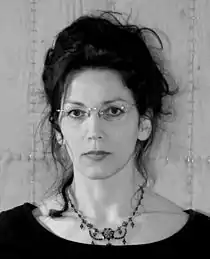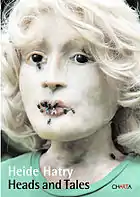Heide Hatry
Heide Hatry (born 1965) is a New York City and Berlin based German neo-conceptual artist, curator and editor. Her work, often either body-related or employing animal flesh and organs (cf: bio-art), has aroused controversy and has been considered horrific, repulsive or sensationalist by some critics, while others have hailed her as an "imaginative provocateur",[1] "a force of nature..., an artist and a humanist who is making a selfless contribution to life",[2] and an artist whose works provoke a "reaction akin to having witnessed a murder".[3]

Biography
Hatry grew up on a farm in the outskirts of Holzgerlingen. She left home at the age of 15 to enroll in a sports school. Later she studied painting, printing, typography, photography, and sculpture at various art schools including Akademie der Bildenden Künste in Stuttgart and Pädagogische Hochschule in Heidelberg, as well as art history at the University of Heidelberg. After many years teaching painting while working in the antiquarian book trade in Heidelberg, she began her career as a visual artist in 2003 in New York.
Art career
Her first solo show took place at Volume Gallery in Chelsea in October, 2004 and consisted of a diverse group of paintings, objects and unique books, with an emphasis on new work that would eventually become part of her book project entitled SKIN.[4] In addition to being the documentation of several years of work with a highly eccentric art material, SKIN is a complex and thoroughly-conceived conceptual project in which Hatry plays on the fact that skin is the medium through which individual identity is most commonly received. The seven female artists all working with skin as a medium are in fact seven facets of Hatry herself. In the book, she fragments her own biography and accordingly distributes aspects of the work among seven individuals. Hatry prevailed upon nine art historians, critics, curators and thinkers (Susanna Partsch, Heinz-Norbert Jocks, Renée Vara, Michaël Amy, Elsbeth Sachs, Cornelia Koch, Christoph Zuschlag, Veronica Mundi and Hans Gercke) to participate in the project, maintaining the conceit and treating each of their subjects as unique, living, artists. Hatry created an artist portrait for each of her individual "selves" using prosthetics and make-up, in a manner akin to the work of Cindy Sherman.

At least one of these portraits has itself become a recognizable contemporary feminist icon (cf: Betty Hirst).[5] During several events relating to the exhibition, Hatry or an actress she engaged, would play the role of one or more of her fictional selves. The book is characterized by mis-direction and deception of many sorts and on various levels, including reference to non-existent artists, books, and passages in (real) books, misquotation, illusory footnotes, false attribution, and pseudonymy, including dissembling gender identities, while nevertheless forwarding legitimate critical theses.

The art which SKIN documents is of a very diverse character, including sculptural objects, some of a realistic nature, some invoking comparison to African or Etruscan masks or statuary, two-dimensional abstract constructions, paintings in blood, and paintings treating art-historical subjects seen through a film of animal bladder or translucent animal skin, reminiscent of certain work by Doris Salcedo, and creating the impression of a heightened realism, a portrait actually "in the flesh". Hatry was the first artist to use untreated pigskin and other animal parts to create realistic depictions, chiefly sculptural, of the human visage, sometimes of a character suggestive of renaissance art. She has experimented with numerous preservation techniques, including the now-famous "plastination" method of the prominent pathologist, and impresario Gunther von Hagens.
The exhibition for which SKIN served as the putative catalogue, significantly avant la lettre, was mounted in numerous private and public venues in the United States and Europe and Hatry’s “own” contribution, a performance was documented by Cosmoto.[6]
Her second large-scale project, Heads and Tales,[7] was also documented in a book, published in English by Charta in 2009.

Heads and Tales is a collaborative endeavor between Hatry and twenty-seven female authors whom she invited to create "lives" for a series of sculptural busts of women. The often eerie or haunting visages were produced using untreated pig skin, flesh and body parts, and the original objects decayed shortly after their creation. Hatry documented the busts in the photographs, which illustrate the published book. The literary evocations of these women's lives treat a wide range of female experience, but frequently address the violence, abuse, suffering and subordination that Catharine MacKinnon describes in her introduction to the volume as the common lot of women: "Finding a way to be a woman is finding a way to live with fatal knowledge."[8] Heads and Tales was exhibited in museums and commercial galleries including New York, Cambridge (US), Los Angeles, Madrid, and Berlin. Hatry's collaborators in the project included Jennifer Belle, Mei-mei Berssenbrugge, Svetlana Boym, Rebecca Brown, Mary Caponegro, Thalia Field, Diana George, Thyrza Nichols Goodeve, Jessica Hagedorn, Elizabeth Hand, Katia Kapovich, Lydia Millet, Micaela Morrissette, Selah Saterstrom, Iris Smyles, Luisa Valenzuela, and Can Xue.
Not a Rose,[9] also a collaboration and documented in a book, was introduced by MoMA PS1,[10] Strand Books,[11] Barnes & Noble, McNally Jackson, and others. It addresses the meaning of flowers and animals to human beings. Masked as a traditional coffee table book, it quotes from the genre while turning it inside out, "subtly undermining our notion of the meaning of beauty".[12] The images it offers are not innocent pretty flowers but elegant, compelling, and yet grotesque sculptures that the artist has created from the offal, sex organs, and other parts of animals, “pushing us into a realm where we question our relationship with beauty, animals, and dinner",[13] the foundations of aesthetic reception in general and our use and abuse of nature. 100 prominent intellectuals, writers, and artists (such as Jonathan Ames, Stephen T. Asma, Bazon Brock, Karen Duve, Jonathan Safran Foer, Steven Connor, Anthony Haden-Guest, Donna Haraway, Siri Hustvedt, Thyrza Goodeve, Lucy Lippard, Richard Macksey, Kate Millett, Richard Milner, Hannah Monyer, Rick Moody, Avital Ronell, Stanley Rosen, Steven Pinker, Peter Singer, Justin E. H. Smith, Klaus Theweleit, Luisa Valenzuela, and Franz Wright...) address “the question of the flower” from a multiplicity of perspectives, including anthropology, philosophy, psychology, sociology, philology, botany, neuroscience, art history, gender studies, physics, and chemistry.

Between 2004 and 2014, Hatry also created a significant body of performance works, many documented in videos, including "Skin Room",[14] which was performed in the Heidelberger Kunstverein, Germany; "Politics",[15] which was performed on 9/11, 2007 in Central Park, New York, with a huge American flag made out of pigskin and spattered with blood; and her best-known performance-work, "Expectations", which has been presented at several venues including the Hudson Valley Center for Contemporary Art, Peekskill, NY; Brown University, Providence, RI; Studio Soto, Boston, MA; Kunstverein Nord, Berlin, Germany; and the 10th Barcelona Art Contemporari Festival, Barcelona.
Hatry's newest collaboration Icons in Ash is a social, humanistic and aesthetic project that proposes a new way of seeing and honoring the dead. Hatry's Icons in Ash mosaics are completely hand-made realistic portraits from human ashes. The project is accompanied by the book publication, Heide Hatry: Icons in Ash, in which twenty-seven contributing authors have offered a multiplicity of perspectives on the human relationship to death. The contributors include Michaël Amy, Hans Belting, Mark Dery, Thyrza Nichols Goodeve, Anthony Haden-Guest, Eleanor Heartney, Phoebe Hoban, Siri Hustvedt, Claudia Steinberg, Thomas W. Laqueur, Jonas Mekas, Lydia Millet, Rick Moody, Marc Pachter, Steven Pinker, George Quasha, Wolf Singer, Luisa Valenzuela, Adele Tutter, Peter Weibel, Linda Weintraub, and Naief Yehya. These cover a wide range of topics, from art history through anthropology, psychology, philosophy, semiotics, ecology, and beyond, as well as discussing death taboos, post-mortem practices, personal experience, the impact of the relic and more.
Hatry has frequently served as a curator. Her numerous solo and group exhibitions have included work by Carolee Schneemann,[16] Tania Bruguera, Jana Sterbak, Zhang Huan,[17] Kate Millett, Theresa Byrnes,[18] Regina Jose Galindo, Minnette Vári,[19] Larry Miller, Pat Steir, Richard Humann, Dove Bradshaw, Chrissy Conant, Peter Downsbrough, Max Gimblett, Chie Hasegawa,[20] Kahn & Selesnick, Annette Lemieux, Aldo Tambellini,[21] and many others...
She has also edited many books and catalogues, and her own unique artist's books "treating texts by Paul Celan, Frederic Tuten, Friedrich Hölderlin, Johann Wolfgang Goethe, John Keats, Samuel Beckett, Walter Abish, Jorge Luis Borges",[22] Franz Wright, Robert Kelly,[23] and David Sedaris among others, are held in many private and public collections.
Selection of Books and Catalogues
- HATRY, Heide: Icons in Ash. New York: Station Hill Press in association with Ubu Gallery, 2017.
- HATRY, Heide: Not a Rose. Milan/New York: Charta, 2012/13.
- HATRY, Heide (Ed.): One of a Kind, Unique Artist's Books, Pierre Menard Gallery, Cambridge, MA, 2011; Dalhousie Gallery, Halifax, Canada; Owens Art Gallery, Mount Allison University, Sackville, Canada; AC–Institute, New York, NY, 2nd ed., 2013.
- HATRY, Heide: Heads and Tales. New York/Milan: Charta, 2009.
- HATRY, Heide (Ed.): Meat After Meat Joy. New York/Cambridge, MA: Daneyal Mahmood Gallery/Pierre Menard Gallery, 2008.
- HATRY, Heide (Ed.): Carolee Schneemann. Cambridge, MA: Pierre Menard Gallery, 2007.
- HATRY, Heide: Skin. Heidelberg: Kehrer, 2005.
See also
Notes
- Robert Shuster. "Introducing Heide Hatry,... Three New York City artists you probably don't know, but should". Village Voice.
- Macu Moran. "Controversy Surrounds Artist Heide Hatry Success – Heads and Tales in Madrid During ARCO 2010". Prnewswire.
- Julie Oakes. "Heide Hatry". The Drawers.
- "Heide Hatry". Publisher's website. Kehrer Verlag.
- "Meat after Meat Joy". Eat me daily. "Betty Hirst's work slide show". Pierre Menard Gallery.
- Cosmoto. "Video of Skin Room performance". Cosmoto website.
- "Heide Hatry. Heads and Tales". Distributor's website, D.A.P. Charta Art Books.
- Catharine MacKinnon. "Introduction - Giving Her Life". Heads and Tales.
- "Heide Hatry. Not a Rose". Distributor's website, D.A.P. Charta Art Books.
- "When a Cow Vagina Becomes a Flower with Avital Ronell, Steven Pinker, Dale Jamieson, Linda Weintraub, and others". MOMA PS1."Heide Hatry's Not a Rose: Disgust and the Cult of the Flower". Artvironmentalist.
- Censorship: An Open Discussion About Disguising The Provocative, at Strand Books on YouTube
- Annie Dillard from her blurb for Not a Rose
- David Streitfeld, Columnist, New York Times, from his blurb for Not a Rose
- Heinz-Norbert Jocks. "Der Geist der Schwelle im Licht tradierter Rituale". Kunstforum (in German).
- Robert Shuster. "Introducing Heide Hatry,... Three New York City artists you probably don't know, but should". Village Voice.
- "Carolee Schneemann". Weekly Dig. Archived from the original on 2015-07-21. Retrieved 2015-07-19.
- "Carne Diem. What meat art can tell us about life and death". Meatpaper.
- Maura Reilly. "Much More Than Meat Joy". Brooklynmuseum.
- James Wagner. "Out of the Box, at Elga Wimmer".
- Mike Landry. "An ice-ax to break your frozen soul. Interview with Mike Landry" (PDF). Telegraph Journal.
- Joyce Beckenstein. "New York-One of a Kind: Unique Artist's Books: AC Institute". Sculpture Magazine.
- "Heide Hatry. Skin Treatments". Exhibition.
- "BP backlash: Artists bite back". Mutualart.
External links
- Website of artist Heide Hatry
- Allison Meier. "Memorial Portraits Made with the Subjects’ Ashes" in Hyperallergic
- Interview with Heide Hatry (Thyrza Goodeve and Laila Pedro) in Brooklyn Rail
- Heide Hatry, Icons in Ash Memorial Project website
- Interview with Carolee Schneemann and Heide Hatry with Thyrza Nichols Goodeve in Brooklyn Rail
- Claudia Steinberg. “Perverse Poesie” in ARTInvestor (in German)
- Ute Thon. “Blumen des Bösen” in Art Magazin (in German)
- Pia Cordero. “Potentia formae est” in Arteallimite (in English and Spanish)
- Interview with Heide Hatry and Ron Broglio in Antennae Magazine
- Evan J. Garza. "Slideshow: Heide Hatry at Pierre Menard Gallery" The Phoenix
- Cosmoto. "SKIN", video documentation of Skin Room